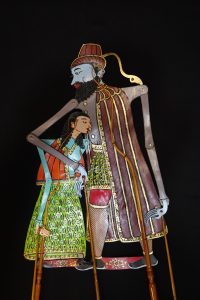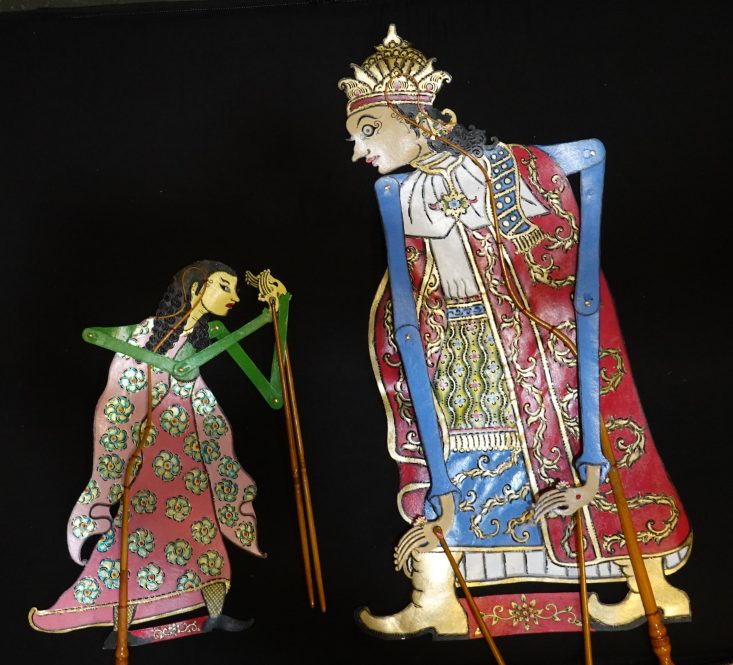Bringing together this month’s Purim Spectacular at the Mandell Jewish Community Center in West Hartford means uniting pieces from as far as central Java and New Zealand and as close as New York City and Storrs for a shadow theater performance rooted in Indonesian tradition but with a Chicago twist.
UConn dramatic arts professor Matthew Isaac Cohen and a group of UConn puppet arts students have put their thumbprints on a revival of the 2001 Barbara Benary show “Wayang Esther: A Javanese Purimspiel,” which they will perform March 12 and 13 at the JCC.
In putting together the show, conceived last year when a West Hartford community member with ties to UConn proposed a puppet play for Purim, Cohen says organizers looked to Benary’s work that depicts a satiric feminist and antiwar take on the story of Queen Esther.

The biblical text is usually read on the holiday of Purim to acknowledge Esther’s role in saving the Jews from execution at the hands of Haman, who ordered their deaths, and celebrate their survival. The holiday is meant as a carnivalesque celebration with drink and food, in addition to a spiel, or play, to convey the story to the next generation.
Both Benary and Cohen use the Indonesian wayang form of shadow puppetry to tell the story. Also from Benary’s show, Cohen has collaborated with the New York City percussion group Gamelan Son of Lion for music performed using gamelan instruments made by Benary and based on Indonesian traditional models.
Puppeteer Ki Joko Susilo, who worked with Benary on her show, was commissioned to create new puppets for UConn’s version and worked with Storrs students from his home in New Zealand via Zoom to teach them about their construction, which was done in central Java, Cohen says. The students then spent the early part of the spring semester constructing replicas – all of which, replicas and originals, are based on an 18th century Italian megillah, or scroll, that lays out the story.
“Our new version of the spiel incorporates most but not all of the original songs written for ‘Wayang Esther,’ but has a very different kind of dramaturgy,” Cohen says. “In the original production, the vocalists, who were not the puppeteers, voiced all the characters and did all the singing. That wasn’t going to be practical from our perspective because we were rehearsing in different sites, with Son of Lion in New York City and the rest of the show in Storrs. So, the dialog has been moved to me as the principal puppeteer.”
Additionally, he says, the librettos have been revised to adopt a Balinese-style of performance, meaning the main characters will speak biblical Hebrew and a cast of clowns will interpret for the audience. To create shadows, Cohen says the puppets will be held against a wayang screen that’s lit from behind to broadcast their shadows on the other side.
The Chicago influence comes in how the performance will be done.
Cohen has reversed the usual set up of the stage, putting puppeteers out front and showing off their work and the bright colors of the puppets themselves. Lighting and projection designer Nicole Lang from Yale University will capture the shadow images digitally and project them in live-edited form using a movie projector on the back wall.
“This is a style of shadow theater that’s been popularized by a Chicago-based group, Manual Cinema. You can choose to look at how things are done on the puppeteer’s side, or you can look at the finished product that’s projected,” he says.
To drum up interest and connect with community members ahead of the show, Cohen and Matthew B. Sorensen ‘22 MFA curated a pre-show exhibit at the JCC, including UConn’s puppet replicas, a reproduction of the scroll of Esther, other puppets from Java, early sketches used in this performance, and music from the 2001 “Wayang Esther.”
“It’s been very good to get the community prepared for the production. They’re able to see and interact with elements of it,” Cohen says. “Most importantly, the preschool children at the JCC can touch the puppets and have a dialog between King Ahasuerus and Queen Esther. They can see how the puppets are on the screen and they can go around the back side and see the shadows. The puppets also are going to be taken around for the children to interact with in their own classrooms.”
Because the story of Esther concludes with the killing of Haman, his sons, and other bloody episodes, Cohen says the 8 p.m. March 12 performance is for adults only and will lay out the full story and have a moment of lamentation and repentance even though Purim is typically a celebratory time.
The 2 p.m. March 13 family-centric show will not include the most brutal events or the philosophical reflection, Cohen says. Instead, it will begin with a march of costumed children to honor Mordechai with a parade and there will be a family sing-along at the end.
To purchase tickets to “Wayang Esther: A Contemporary Retelling of the Book of Esther,” visit the Mandell Jewish Community Center website. The pre-show exhibition is ongoing now.



